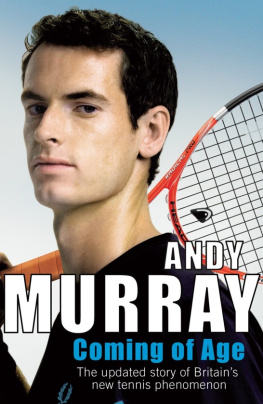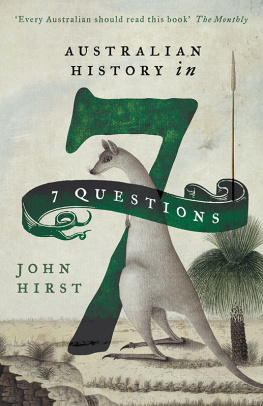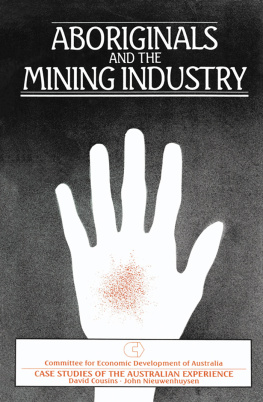THE MAKING OF AUSTRALIA
A CONCISE HISTORY

Opening up the continent from a white perspective. (Australian Encyclopaedia)
THE MAKING OF AUSTRALIA
A CONCISE HISTORY
Robert Murray
ROSENBERG
First published in Australia in 2014
by Rosenberg Publishing Pty Ltd
PO Box 6125, Dural Delivery Centre NSW 2158
Phone: 61 2 9654 1502 Fax: 61 2 9654 1338
Email:
Web: www.rosenbergpub.com.au
Copyright Robert Murray
National Library of Australia Cataloguing-in-Publication entry
Author: Murray, Robert, 1932- author.
Title: The making of Australia : a concise history / Robert Murray.
ISBN: 9781925078152 (paperback)
Epdf ISBN: 9781925078268
Epub ISBN: 9781925078275
Notes: Includes bibliographical references and index.
Subjects: Australia History.
Dewey Number: 994

Fish trap on the Darling River, NSW. Fish, a principal food source, were trapped there when the river level fell after floods. Aborigines used these and other advances on nature in some parts of Australia. (Museum of Applied Arts and Sciences, Sydney).
Contents
Foreword
During the 1980s Australia suffered from an overdose of history brought on by the observance of the bicentenary of European settlement in 1988. Already under assault from a new awareness of the dispossession of the Aboriginal people and the destruction of the natural environment by European-style development, feminist questioning of the long-held orthodoxy of Australian history as the achievement of a working mans paradise had introduced further uncertainties into the reading of Australian history.
The debates of the 1980s over whether Australia was invaded or settled by Europeans were then succeeded in the 1990s by Paul Keatings enthusiasm for an Australian republic, his desire to recast Australian history as independent of Britain by shifting the emphasis from World War I and Gallipoli to World War II and Kokoda, and to encourage the true believers of the labour movement. With John Howard as prime minister subsequently we struggled to overcome what had become known as the black armband version of our history, a gloomy tale of environmental destruction, repression of minorities and loss of pride in our British heritage, and to recover the true meaning of the mateship that had made us a great and glorious nation, not only at Gallipoli and on the Western Front but at cricket and in sporting contests in general. The History Wars under Howard turned history itself into something of a minefield. Students became unsure of what line they should take to be considered correct or were bored by the bickering. Australian history became tiresome, polemical, narrow or dull, a subject to be avoided.
When asked by the occasional overseas visitor or rare self-improving reader what they might read to gain a workable sense of the past in Australia, it was not easy to suggest a clear, comprehensive account. But Bob Murray has now written a book that is sensitive to the serious debates, though not bogged down in any of them. His simple purpose is to tell his story of how modern Australia came to be the way it is today, beginning with the arrival of the earliest Aboriginal settlers floating on logs or canoes across the then shallow seas to the north and concluding with the rise of Tony Abbotts government.
Once it was easy to cover Australias history in a single volume, but the past few decades have seen the story lengthen not only at the beginning by many thousands of years of Aboriginal occupation, and at the end with the ever-faster rise and fall of governments, but also by the increasing complexity within the story itself. Some readers may be disappointed by the relative amount of space devoted to their own particular preoccupations, within our history, but more will find Murrays quick march, especially through the major economic and political developments, stimulating and provocative, or informative and enlightening.
Beverley Kingston, Pearl Beach, December 2013
NOTE
Under the Imperial measurement system used in Australia until 1973, a mile equalled approximately 1.6 kilometres and an acre 0.4 hectares. One Australian pound () equalled $A2 under the old money units used until 1966. A pound contained 20 shillings. As a very rough guide, one pound in the nineteenth century would have purchasing power equal to perhaps $100 in the early twenty-first century but conditions change too much over two centuries to justify any more precise indication.
Acknowledgments
Writing history requires teamwork. I am indebted to the many others who have written on Australian history, whose work has helped inspire this effort. Frank Clune, Ion L. Idriess and Mary Grant Bruce captured my interest early and dozens of others have since.
Librarians are also part of the team. I thank collectively the many helpers from the Baillieu, Latrobe, Mitchell, National, Northern Territory, Tasmanian and other major libraries and, among smaller libraries, Bayside in Melbourne and Penrith in NSW. Jim Kohens and John Mulvaneys expertise on indigenous prehistory was essential.
Thanks too to the cartoonists who have helped illustrate the story.
Many of the individuals who helped by reading all or parts of the manuscript and in other ways are old friends: Tony Andrews, Frank Clarke, Mervyn Dundas, Peter Ellery, Kevin Hilferty, Ian Jelfs, Beverley Kingston, John Lack, Andrew Lemon, Malcolm Maiden, Tony Maiden, Jean Mullins, Jim Murray, Peter Ryan, Jim Usher, Kate White, Jan Wilson and Keith Windschuttle.
It was a stroke of luck that in the mid-1980s Penrith City Council commissioned me (with Kate White) to write a history of early settlement there between 1800 and 1860. During work on it, the ex-convict settlers and Aborigines of that distant time became real people with real faces and living descendants. The commission resulted in Dharug and Dungaee: The History of Penrith and St Marys to 1860, published by Hargreen in 1988 as a Bicentenary project.
I am indebted also to my parents, John and Sylvia Murray, and their frequent accounts of their forebears. Together they lived a large part of this story.
Robert Murray, Melbourne, December 2013
Log Rafts and Sails
Travellers to Australia these days fly in a few hours in huge jet airliners from sparkling, high tech and brightly lit airports in cities like London, Los Angeles, Singapore and Tokyo. It was not always like this. The first humans to visit this southern continent probably arrived on the northern coast from Indonesia or Timor. The event was momentous but unrecorded; there are no written records of Australian life until the 1600s. Modern detective work based on archaeology, anthropology and climate studies indicates a likely time of human arrival as perhaps 60,000 years ago or more, and at least 40,000 years ago. This was very early in the history of modern mankind. Modern mankind is believed to have first evolved in Africa about 100,000 years ago and to have crossed into what is now the Arabian Peninsula about 7080,000 years ago to begin spreading around the world, though there are also theories of even more remote origins in Asia as well. Modern man probably moved early into what is now India, and from there to Indonesia and on to Australia. He (and she) did not enter Europe until 50,000 years or less ago and the British Isles and the Americas only long after that.
Those first immigrants were likely ancestors of the Australian Aborigines. Several small groups may have landed over many years. Little is certain about human events so remotely distant in time though they are believed to have crossed from Timor or Indonesia by floating log or simple raft. The sea gap between Australia and the Indonesian archipelago shrank at times to as little as 100 kilometres during the severe ice age that affected the earth between 100,000 and 10,000 years ago. The freeze soaked up the sea water into ice in the higher latitudes. This enormously reduced ocean levels in the tropics, so that the Australian coast extended far beyond the present one. Throughout history, climate change has been a major reason for human migration.
Next page


















